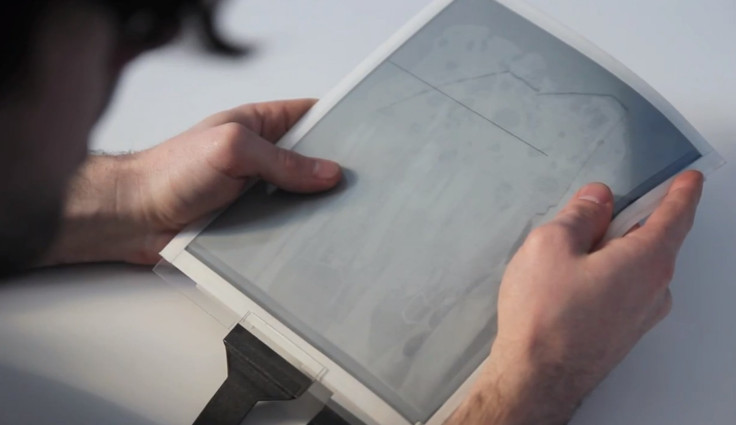PaperTab: A Tablet As Flexible As Paper Debuts At CES 2013 [VIDEO]

Here's one exciting consumer gadget at CES 2013 that isn't a television: The PaperTab, which looks and feels just like a sheet of paper, may one today overtake today's tablets.
Developed by researchers at the Human Media Lab at Queen's University in Ontario, Canada, the PaperTab features a flexible, high-resolution 10.7-inch plastic touchscreen display built by Plastic Logic, the company borne from Cambridge University's Cavendish Laboratory, and relies on a second-generation Intel Core i5 processor to turn what looks like a sheet of white paper into a living, interactive display.
"We are actively exploring disruptive user experiences," said Ryan Brotman, an Intel research scientist. "The 'PaperTab' project, developed by the human media lab at Queen's University and Plastic Logic, demonstrates innovative interactions powered by Intel core processors that could potentially delight tablet users in the future."
Unlike typical tablets akin to Apple's iPad, the idea of PaperTab is to use one app at a time, per Papertab. To make tasks easier, users would own 10 or more PaperTabs at once and lay them out to their liking -- think the police department in "Minority Report," but with paper -- with one app running in each interactive "window."
"Plastic logic's flexible plastic displays are completely transformational in terms of product interaction," said Indro Mukerjee, CEO of Plastic Logic. "They allow a natural human interaction with electronic paper, being lighter, thinner and more robust compared with today's standard glass-based displays. This is just one example of the innovative revolutionary design approaches enabled by flexible displays."
With multiple tablets to separate applications, PaperTab relies on an interface that lets the user combine and merge elements from disparate applications with intuitive dragging, dropping, pointing and folding. For example, to reply to an email within the inbox on one PaperTab, one simply touches the email with another PaperTab and curl the top right corner. A keyboard instantly appears on the PaperTab to type the message; to add a photo, find the photo on another PaperTab and touch it directly to the email reply. The photo instantly appears within the email message. Users also can instantly pick up documents by touching one PaperTab to another distant PaperTab with a group of PDF icons.
While the PaperTab is a touchscreen display, it doesn't accept typical gestures users will know from the iPad. Instead, using the PaperTab is a much more physical experience. To flip through pages in a book or article, one can fold your PaperTab in half or curl the right side of the page. To fast-forward or rewind a video, simply bend the top corners of the tablet. To see a picture in a bigger frame, the user can put two PaperTabs next to each other, and they're smart enough to create one big picture. Even when two Papertabs are "attached," since everything is editable, it's easy to drag and drop icons or objects from one PaperTab to the other.
"Using several PaperTabs makes it much easier to work with multiple documents," said Roel Vertegaal, the director of Queen's University's Human Media Lab. "Within five to 10 years, most computers, from ultra-notebooks to tablets, will look and feel just like these sheets of printed color paper."
While the PaperTab is not yet ready for prime time -- the Intel i5 processor is housed in an outside unit, which connects to all of the PaperTabs, as seen in the video provided by Queen's University -- the technology is very promising. Since PaperTab is both lightweight and robust, they can be bent, thrown around and collected, which isn't so easy to do with today's tablets. Intel's Brotman believes this particular product could be ready "within five to 10 years."
To learn more about the PaperTab, watch the video below and check out Queen's University's human media lab.
© Copyright IBTimes 2024. All rights reserved.






















